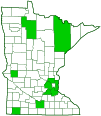Common green lacewing
(Chrysoperla carnea group)
Conservation • Description • Habitat • Ecology • Distribution • Taxonomy
Conservation Status |
|||
| IUCN Red List | not listed |
||
| NatureServe | NNR - Unranked |
||
| Minnesota | not listed |
||
Description
Common green lacewing is a widespread, very common, medium-sized, net-winged insect. It occurs in Europe, Asia, North Africa, and North and South America. True to its common name, it is the most common green lacewing worldwide.
Adults are ½″ to ¾″ long and have a wingspan of ⅞″ to 1¼″. The body is long and slender, and has a delicate appearance. The thorax and abdomen are pale green and often have a thin, pale yellow stripe above. The antennae are long and thread-like. The eyes are gold or copper-colored.
The wings are transparent with a network of pale green veins. The forewing and hindwing are the same size and shape. The subcostal vein (Sc) is not fused with the anterior branch of the radial vein (R1) at the wing tip. The costal cross-veins are not forked. The wings are held roof-like over the body when at rest.
Third stage (instar) larvae are alligator-like in appearance, ¼″ to 5 ⁄16″ long, and have long, sickle-shaped mandibles. They have well-developed legs which allow them to move quickly.
Size
Total length: ½″ to ¾″
Wingspan: ⅞″ to 1¼″
Similar Species
Habitat
Open areas: meadows, agricultural crops, and human houses
Ecology
Season
Two or three generations per year: spring to autumn
Behavior
Adults are nocturnal, active from sunset to sunrise. They are attracted to lights. They may emit an unpleasant odor when handled.
Life Cycle
Overwintering adults become active in the spring. The female lays eggs singly on foliage. She can lay two to five eggs per day and several hundred over her lifetime. The eggs are oval, pale green, and held at the end of long, slender stalks. They hatch in three to six days and the larvae pass through three instars in two to three weeks. They pupate in a silk, pea-shaped cocoon. Adults emerge in ten days to two weeks. There are at least two or three generations per year. In the fall, adults of the last generation become straw-colored. They group together in leaf litter usually at the edge of a field and enter a state of suspended development (diapause).
Larva Food/Hosts
Mostly aphids, but also many species of insects and arachnids, including adult aphids, spider mites, thrips, and whiteflies; eggs of leafhoppers, moths, and leafminers; and larvae of butterflies, moths, and beetles.
Adult Food
Flower nectar and pollen, and aphid honeydew
Distribution |
||
|
Sources Biodiversity occurrence data published by: Minnesota Biodiversity Atlas (accessed through the Minnesota Biodiversity Atlas Portal, bellatlas.umn.edu, 10/4/2025). |
|
| 10/4/2025 | ||
Occurrence |
||
very common |
||
Taxonomy
Order
Neuroptera (antlions, lacewings, and allies)
Suborder
Hemerobiiformia (lacewings and allies)
Family
Subfamily
Chrysopinae (typical green lacewings)
Tribe
Genus
Chrysoperla (common green lacewings)
Subordinate Taxa
common green lacewing (Chrysoperla adamsi)
common green lacewing (Chrysoperla agilis)
common green lacewing (Chrysoperla zastrowi sillemi) ![]()
Downes’s green lacewing (Chrysoperla downesi) ![]()
Johnson’s green lacewing (Chrysoperla johnsoni) ![]()
weeping green lacewing (Chrysoperla plorabunda) ![]()
![]()
Synonyms
Chrysopa vulgaris
Common Names
This species group has no common name. The common name of the genus Chrysoperla is common green lacewings, and it is applied here for convenience.
Glossary
Instar
The developmental stage of arthropods between each molt; in insects, the developmental stage of the larvae or nymph.
Visitor Photos
Share your photo of this insect.
This button not working for you?
Simply email us at info@MinnesotaSeasons.com.
Attach one or more photos and, if you like, a caption.
|
||
|
MinnesotaSeasons.com Photos
|

Slideshows

Visitor Videos
Share your video of this insect.
This button not working for you?
Simply email us at info@MinnesotaSeasons.com.
Attach a video, a YouTube link, or a cloud storage link.
Other Videos
Chrysoperla Carnea
daniel garza
La Chrysope verte (Chrysoperla carnea), larves à l’oeuvre, par André Lequet.
André Lequet
La chrysope verte (Chrysoperla carnea): Les parades nuptiales (par André Lequet)
André Lequet
Chrysoperla carnea
Michel-Marie Solito de Solis
Chrysoperla carnea (Common green lacewing)
Guillaume Licken

Visitor Sightings
Report a sighting of this insect.
This button not working for you?
Simply email us at info@MinnesotaSeasons.com.
Be sure to include a location.
MinnesotaSeasons.com Sightings


